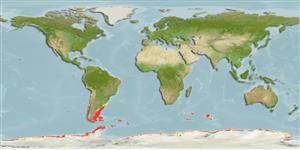Common names from other countries
Environment: milieu / climate zone / depth range / distribution range
Écologie
; profondeur 0 - 190 m (Ref. 87801). Temperate
Southern Ocean.
Length at first maturity / Taille / Poids / Âge
Maturity: Lm ? range ? - ? cm
It is found in forests of Macrocystis pyrifera (Ref. 92889), on hard substrates like rocks, cobbles and boulders in intertidal areas to a depth of 190 m (Ref. 87801).
Life cycle and mating behavior
Maturité | Reproduction | Frai | Œufs | Fécondité | Larves
Members of the class Asteroidea exhibit both asexual (regeneration and clonal) and sexual (gonochoric) means of reproduction. Life cycle: Embryos hatch into planktonic larvae and later metamorphose into pentamorous juveniles which develop into young sea stars with stubby arms.
Adami, M.L. and S. Gordillo. 1999. (Ref. 92889)
Statut dans la liste rouge de l'IUCN (Ref. 130435)
statut CITES (Ref. 108899)
Not Evaluated
Not Evaluated
Menace pour l'homme
Harmless
Utilisations par l'homme
| FishSource |
Outils
Plus d'informations
Taille/ÂgeCroissanceLongueur-poidsLongueur-longueurMorphologieLarvesAbondance
Sources Internet
Estimates based on models
Preferred temperature
(Ref.
115969): 5.9 - 14.6, mean 9.4 (based on 528 cells).
